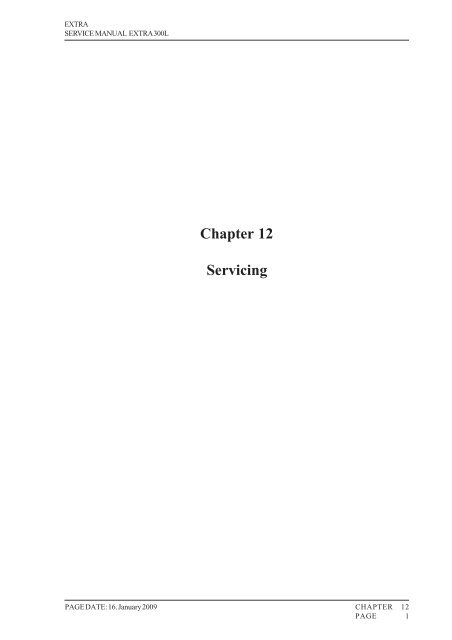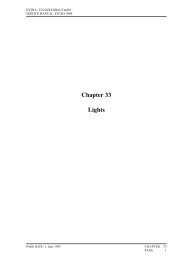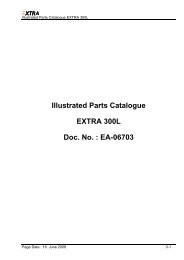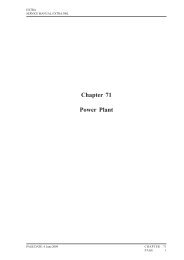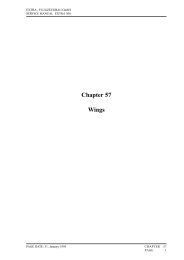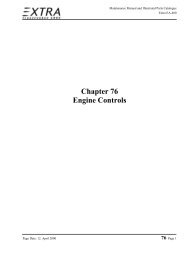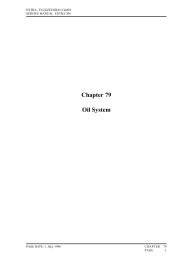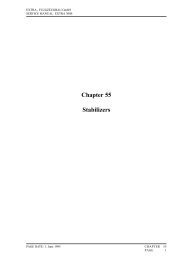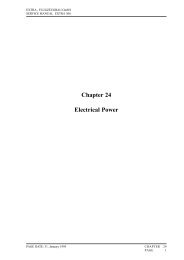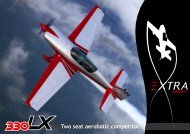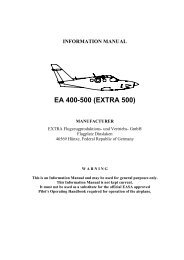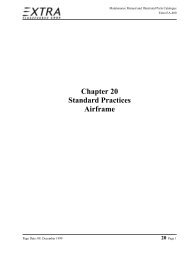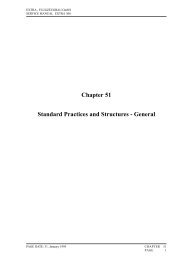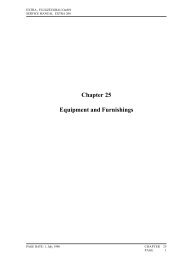Chapter 12 Servicing - Extra Aircraft
Chapter 12 Servicing - Extra Aircraft
Chapter 12 Servicing - Extra Aircraft
Create successful ePaper yourself
Turn your PDF publications into a flip-book with our unique Google optimized e-Paper software.
EXTRA<br />
SERVICE MANUAL EXTRA 300L<br />
<strong>Chapter</strong> <strong>12</strong><br />
<strong>Servicing</strong><br />
PAGE DATE: 16. 1. June January 1995 2009<br />
CHAPTER <strong>12</strong><br />
PAGE 1
EXTRA<br />
SERVICE MANUAL EXTRA 300L<br />
Table of Contents<br />
<strong>Chapter</strong><br />
Title<br />
<strong>12</strong>-00-00 GENERAL . . . . . . . . . . . . . . . . . . . . . . . . . . . . . . . . . . 3<br />
<strong>12</strong>-10-00 REPLENISHING. . . . . . . . . . . . . . . . . . . . . . . . . . . . . 4<br />
<strong>12</strong>-10-01 Refueling . . . . . . . . . . . . . . . . . . . . . . . . . . . . . . . . . . . . 4<br />
<strong>12</strong>-10-02 Defueling. . . . . . . . . . . . . . . . . . . . . . . . . . . . . . . . . . . . 6<br />
<strong>12</strong>-10-03 Fuel Drains . . . . . . . . . . . . . . . . . . . . . . . . . . . . . . . . . . 6<br />
<strong>12</strong>-10-04 Replenishment of Engine Oil. . . . . . . . . . . . . . . . . . . . . 6<br />
<strong>12</strong>-10-05 Oil Change . . . . . . . . . . . . . . . . . . . . . . . . . . . . . . . . . . 10<br />
<strong>12</strong>-10-06 Replenishment of Brake Fluid . . . . . . . . . . . . . . . . . . . 11<br />
<strong>12</strong>-10-07 Tire Inflation . . . . . . . . . . . . . . . . . . . . . . . . . . . . . . . . 13<br />
<strong>12</strong>-20-00 SCHEDULED SERVICING . . . . . . . . . . . . . . . . . . . 14<br />
<strong>12</strong>-20-01 Exterior Cleaning . . . . . . . . . . . . . . . . . . . . . . . . . . . . 14<br />
<strong>12</strong>-20-02 Interior Cleaning . . . . . . . . . . . . . . . . . . . . . . . . . . . . . 15<br />
<strong>12</strong>-20-03 Engine Cleaning. . . . . . . . . . . . . . . . . . . . . . . . . . . . . . 15<br />
<strong>12</strong>-30-00 UNSCHEDULED SERVICING . . . . . . . . . . . . . . . . . 17<br />
<strong>12</strong>-30-01 Removal of Snow and Ice. . . . . . . . . . . . . . . . . . . . . . . 17<br />
PAGE DATE: 16. 1. June January 1995 2009<br />
CHAPTER <strong>12</strong><br />
PAGE 2
EXTRA<br />
SERVICE MANUAL EXTRA 300L<br />
<strong>12</strong>-00-00 GENERAL<br />
This chapter describes the procedures and precautions<br />
nescessary for proper servicing of the EXTRA 300L. The<br />
specified intervals (refer to chapter 5) are considered<br />
adequate to meet average requirements under normal operating<br />
conditions.<br />
It is advisable, however, to shorten service and maintenance<br />
intervals when operating under abnormal conditions, such as<br />
extreme temperature ranges, dusty atmospheric conditions,<br />
high humidity and moisture, unimproved airport facilities,<br />
or unusual operating requirements.<br />
PAGE DATE: 16. 1. June January 1995 2009<br />
CHAPTER <strong>12</strong><br />
PAGE 3
EXTRA<br />
SERVICE MANUAL EXTRA 300L<br />
<strong>12</strong>-10-00 REPLENISHING<br />
The replenishing procedures contained in this section provide<br />
the proper methods for replenishing consumed fuel,<br />
engine oil and brake fluid. Also included are methods for<br />
inflation of tires.<br />
<strong>12</strong>-10-01 Refueling<br />
Refueling is accomplished by pumping or pouring fuel into<br />
the two wing tanks and the center tank through their respective<br />
filler caps. When fueling the aircraft, the following<br />
safety precautions must be followed:<br />
D AN G E R<br />
* Never refuel the aircraft with the engine running.<br />
* Always ensure that the aircraft is grounded before<br />
refueling.<br />
* Ensure that no one is smoking within 100 feet of the<br />
aircraft.<br />
* Ensure that all aircraft electrical systems are<br />
deenergized while refueling.<br />
* Ensure that no aircraft radar or powerful transmitters<br />
are operating within 100 feet of the aircraft during<br />
fueling.<br />
* If fuel is spilled, ensure that the area of spillage is<br />
thoroughly flushed with water and that all residual<br />
fuel and vapor have dissipated or neutralized prior<br />
to starting the aircraft engine.<br />
Fuel Grade and Limitations<br />
The recommended minimum aviation grade fuel for the<br />
AEIO-540-L1B5 and AEIO-580-B1A engine is AVGAS 100<br />
or 100LL.<br />
PAGE DATE: 16. 1. June January 1995 2009<br />
CHAPTER <strong>12</strong><br />
PAGE 4
EXTRA<br />
SERVICE MANUAL EXTRA 300L<br />
REPLENISHING<br />
Refueling<br />
I M P O R T A N T<br />
Under no circumstances should fuel of lower octane rating<br />
or automotive fuel (regardless of octane rating) be<br />
used. It is recommended that personnel be familiar<br />
with Service Instruction No.1070 regarding specified<br />
fuel for Lycoming engines.<br />
Fuel System Capacities<br />
Configuration 1 (with 42 L Center tank):<br />
Wing tank LH 60 L (15.8 US Gallons)<br />
Wing tank RH 60 L (15.8 US Gallons)<br />
Center and acro tank 51 L (13.5 US Gallons)<br />
Total fuel capacity 171 L (45.1 US Gallons).<br />
Usable fuel capacity 165.5 L<br />
(43.6 US Gallons).<br />
Usable fuel capacity<br />
for acrobatic 45.5 L (<strong>12</strong> US Gallon).<br />
Configuration 2 (with 60 L Center tank):<br />
Wing tank LH 60 L (15.8 US Gallons)<br />
Wing tank RH 60 L (15.8 US Gallons)<br />
Center and acro tank 69 L (18.2 US Gallons)<br />
Total fuel capacity 189 L (49.9 US Gallons).<br />
Usable fuel capacity 187 L (49.4 US Gallons).<br />
Usable fuel capacity<br />
for acrobatic 67 L (17.7 US Gallon).<br />
I M P O R T A N T<br />
For acrobatic flight wing tanks must be empty.<br />
I M P O R T A N T<br />
After refueling, it has to be ensured that both fuel tank<br />
caps are securely installed pior to flight.<br />
Additionally one has to wait at least five minutes for moisture<br />
and sediment to settle before draining and checking the<br />
fuel drain valves.<br />
PAGE DATE: 16. 1. June January 1995 2009<br />
CHAPTER <strong>12</strong><br />
PAGE 5
EXTRA<br />
SERVICE MANUAL EXTRA 300L<br />
REPLENISHING<br />
<strong>12</strong>-10-02 Defueling<br />
D A N G E R<br />
During the aircraft defueling observe the safety precautions<br />
specified in section "<strong>12</strong>-10-01 Refueling".<br />
Using appropriate containers, defuel the aircraft by pumping<br />
or by siphoning off fuel through the filler ports (only for the<br />
wing tanks) and by opening the gascolator and center tank<br />
drain valves.<br />
<strong>12</strong>-10-03 Fuel Drains<br />
The EXTRA 300L has three fuel drain valves to provide for<br />
drainage of moisture and sediment. Two fuel drain valves are<br />
located under the fuselage in the area of the landing gear; the<br />
third fuel drain which is interconnectecd to the fuel gascolator<br />
is located in the lowest point at the right side of the firewall.<br />
D A N G E R<br />
Do not drain the fuel system when the engine or the<br />
exhaust is hot or while the wind is strong.<br />
A quantity of fuel must be drained prior to the first flight of<br />
the day and at least five min. after refueling to inspect for<br />
water and/or contamination. Continue draining until free of<br />
water or contamination.<br />
I M P O R T A N T<br />
After draining, you have to be sure that the fuel drain<br />
valve is returned to the closed position and the valve<br />
is not leaking outside the aircraft.<br />
<strong>12</strong>-10-04 Replenishment of Engine Oil<br />
The engine oil replenishment is accomplishment by pouring<br />
oil into the oil filler spout. The oil quantity can be conveniently<br />
checked by use of the dipstick attached to the oil filler spout<br />
cap.<br />
PAGE DATE: 16. 1. June January 1995 2009<br />
CHAPTER <strong>12</strong><br />
PAGE 6
EXTRA<br />
SERVICE MANUAL EXTRA 300L<br />
REPLENISHING<br />
Replenishment of Engine Oil<br />
Oil quantity<br />
The oil quantity is checked as follows:<br />
1 Check oil level after engine has been stopped long enough<br />
for oil to drain back into sump.<br />
2 Open the hatch on the upper part of the cowling.<br />
3 Unsrew oil filler cap and dipstick from engine oil filler<br />
spout.<br />
4 Remove cap and dipstick from engine and wipe oil from<br />
dipstick with a clean cloth or paper towel.<br />
5 Return dipstick into filler spout and tighten finger tight.<br />
6 Unsrew and remove dipstick. Check oil level on dipstick<br />
versus the markings stamped on the dipstick.<br />
7 If replenishment is required see "Replenishment of Engine<br />
Oil" below.<br />
8 Return dipstick into filler spout and tighten cap finger<br />
tight.<br />
C A U T I O N<br />
When tightening the filler spout cap ensure that is secure.<br />
But do not overtighten, as this may damage the<br />
"O" ring seal in the cap.<br />
9 Close the hatch on the upper part of the cowling.<br />
Replenish engine oil<br />
Replenish engine oil using oil of the following specification:<br />
Aviation Grade Straight Mineral oil<br />
MIL-L-6082 or SAE J1966 Aviation Grade Straight Mineral<br />
oil shall be used to replenish oil supply during the first 25<br />
hours of operation and at the first 25-hour oil change.<br />
Continue to use this grade of oil the first 50 hours of<br />
operation or until oil consumption has stabilized. The<br />
aircraft is delivered from EXTRA-Flugzeugproduktionsund<br />
Vertriebs GmbH with proper break-in oil (MIL-L-6082<br />
Aviation Grade Straight Mineral oil ).<br />
PAGE DATE: 16. 1. January June 1995 2009<br />
CHAPTER <strong>12</strong><br />
PAGE 7
EXTRA<br />
SERVICE MANUAL EXTRA 300L<br />
REPLENISHING<br />
Replenishment of Engine Oil<br />
Ashless Dispersant Oil<br />
MIL-L-22851 or SAE J1899 Ashless Dispersant Oil shall be<br />
used after the first 50 hours of the engine operation.<br />
Additive Oil<br />
If an engine has been operating on straight mineral oil for<br />
several hundred hours, a change to additive oil should be<br />
undertaken with caution. If the engine is in an extremely dirty<br />
condition, the switch to additive oil should be deferred until<br />
after engine has been overhauled.<br />
When changing from straight mineral oil to additive oil take<br />
the following precautionary steps:<br />
I M P O R T A N T<br />
1 Do not mix additive oil and straight mineral oil.<br />
Drain straight mineral oil from engine and fill with<br />
additive oil.<br />
2 Do not operate engine longer than five hours before<br />
again changing oil.<br />
3 Check oil screen for evidence of sludge.<br />
Change oil and clean oil screen element every 10 hours if<br />
sludge is evident. Resume normal oil drain periods after<br />
sludge conditions improve.<br />
PAGE DATE: 16. 1. June January 1995 2009<br />
CHAPTER <strong>12</strong><br />
PAGE 8
EXTRA<br />
SERVICE MANUAL EXTRA 300L<br />
REPLENISHING<br />
Replenishment of Engine Oil<br />
Recommended Viscosity of Engine Oil:<br />
Average Ambient<br />
Air Temperature<br />
MIL-L-6082 or<br />
SAE J1966 Spec.<br />
Mineral Grades<br />
All Temperature ----------<br />
MIL-L-22851 or<br />
SAE J1899 Spec.<br />
Ashless Dispersant<br />
Grades<br />
SAE 15W50 or<br />
SAE 20W50<br />
Above 27°C (80°F) SAE 60 SAE 60<br />
Above 16°C (60°F) SAE 50 SAE 40 or SAE 50<br />
-1°C (30°F) to 32°C (90°F) SAE 40 SAE 40<br />
-18°C (0°F) to 21°C (70°F) SAE 30<br />
-18°C (0°F) to 32°C (90°F) SAE 20W50<br />
Below -<strong>12</strong>°C (10°F) SAE 20<br />
SAE 30, SAE 40 or<br />
SAE 20W40<br />
SAE 20W50 or<br />
SAE 15W50<br />
SAE 30 or SAE<br />
20W30<br />
N O T E<br />
Refer to latest revision of Lycoming Service Instruction<br />
No. 1014 for further information.<br />
Replenish engine oil as follows:<br />
1 Open the hatch on the upper part of the cowling and<br />
unsrew oil filler cap.<br />
2 Using a clean paper towel wipe any oil foreign material<br />
from the edges of the filler spout opening. Also wipe oil<br />
from the dipstick.<br />
3 Pour oil of proper specification and viscosity into filler<br />
spout to achieve desired oil level.<br />
4 Replace oil filler spout cap/dipstick and tighten finger<br />
tight. Close the hatch on the upper part of the cowling<br />
and secure engine cowling.<br />
PAGE DATE: 16. 1. June January 1995 2009<br />
CHAPTER <strong>12</strong><br />
PAGE 9
EXTRA<br />
SERVICE MANUAL EXTRA 300L<br />
REPLENISHING<br />
Oil Change<br />
Oil System Capacities:<br />
<strong>12</strong>-10-05 Oil Change<br />
The engine oil must be changed after 25 hours of operation.<br />
It should be refilled in accordance with section "<strong>12</strong>-10-04<br />
Engine Oil Replenishing" and the latest revision of Lycoming<br />
Service Instruction No. 1014.<br />
At the time of each oil change the engine oil screen at the<br />
engine should be removed, cleaned, and inspected for metal<br />
particles.<br />
Change engine oil as follows:<br />
1 Remove the cowling of the aircraft.<br />
2 Remove the exhaust port of the second engine<br />
cylinder (for easy access to the oil drain).<br />
3 Cut the safety wire securing the oil drain plug.<br />
4 Place a suitable container under the oil drain.<br />
5 Unscrew engine oil drain plug and allow the oil to drain<br />
thoroughly.<br />
6 Remove the oil temp. sensor carefully. Do not cut the<br />
wire.<br />
7 Remove remaining safety wire from drain plug and<br />
safety wire hole on engine.<br />
8 Using a clean rag or paper towel, wipe drain plug clean<br />
and area on engine around oil drain.<br />
9 Reinstall drain plug and safety wire.<br />
PAGE DATE: 16. 1. June January 1995 2009<br />
CHAPTER <strong>12</strong><br />
PAGE 10
EXTRA<br />
SERVICE MANUAL EXTRA 300L<br />
REPLENISHING<br />
Replenishment of Brake Fluid<br />
10 Remove, clean, inspect and reinstall engine oil strainers<br />
in accordance with Lycoming Operating Manual.<br />
11 Reinstall oil temp. sensor.<br />
<strong>12</strong> Replenish engine oil as per <strong>Chapter</strong> <strong>12</strong>-10-04.<br />
13 Reinstall the exhaust port of the second cylinder using<br />
new sealing rings.<br />
14 Reinstall and secure the cowling.<br />
<strong>12</strong>-10-06 Replenishment of Brake Fluid<br />
In order to assure proper brake action, it is necessary to have<br />
positive transfer of hydraulic pressure through the system.<br />
Any air trapped in the system must be removed. Follow the<br />
procedure described below using a bleed tank (1, Figure 1):<br />
1 Remove engine cowlings (Up to serial No. 02 the brake<br />
fluid reservoir is installed at the cockpit side of the<br />
firewall. So in those cases the main fuselage cover has<br />
to be removed too.) as per <strong>Chapter</strong> 51-00-01.<br />
2 Remove fluid reservoir filler plug and screw a clear plastic<br />
hose with appropirate fitting into the filler hole at<br />
the top of the fluid reservoir.<br />
3 Remove bleeder fitting cap (3) of the wheel brake assembly<br />
(2).<br />
PAGE DATE: 16. 1. January June 1995 2009<br />
CHAPTER <strong>12</strong><br />
PAGE 11
EXTRA<br />
SERVICE MANUAL EXTRA 300L<br />
REPLENISHING<br />
Replenishment of Brake Fluid<br />
Replenishment of Brake Fluid<br />
Figure 1<br />
4 Be certain that the bleeding equipment to be used is absolutely<br />
clean and is filled with brake fluid that conforms<br />
to Specification MIL-H-5606, (refer to <strong>Chapter</strong><br />
05-20 Lubrication Charts) and is uncontaminated.<br />
5 Maintain an adequate supply of fluid during the entire<br />
operation. A low fluid supply will allow air to be drawn<br />
into the system.<br />
6 Ensure master cylinders are in neutral position.<br />
7 Attach the connector hose (4) to the bleeder fitting.<br />
8 Turn the bleeder fitting 1/2 rotation to the left for opening.<br />
9 Slowly pump clean hydraulic fluid in the system. Bleeding<br />
should continue until no more air bubbles are expelled<br />
from the system (observe the immersed end of<br />
the clear hose), and a firm brake pedal is obtained (fill<br />
each side of the system with min. 0.33 ltr (0.1 U.S<br />
Gallons) for complete change).<br />
10 Fill the fluid reservoir up to full reservoir capacity.<br />
11 Reinstall fluid reservoir filler plug.<br />
<strong>12</strong> Close bleeder fitting.<br />
PAGE DATE: 16. 1. June January 1995 2009<br />
CHAPTER <strong>12</strong><br />
PAGE <strong>12</strong>
EXTRA<br />
SERVICE MANUAL EXTRA 300L<br />
SCHEDULED SERVICING<br />
13 Disconnect the connector hose.<br />
14 Reinstall bleeder fitting cap.<br />
15 Check the brake operation.<br />
<strong>12</strong>-10-07 Tire Inflation<br />
For the EXTRA 300L the required tire pressure is 3.4 bar<br />
(49,3 Psi) for both main wheels. When inflating tires, it has<br />
to be used regulated air pressure through valve sems.<br />
PAGE DATE: 16. 1. June January 1995 2009<br />
CHAPTER <strong>12</strong><br />
PAGE 13
EXTRA<br />
SERVICE MANUAL EXTRA 300L<br />
SCHEDULED SERVICING<br />
Exterior Cleaning<br />
<strong>12</strong>-20-00 SCHEDULED SERVICING<br />
<strong>12</strong>-20-01 Exterior Cleaning<br />
The painted surface of the aircraft have a long lasting, allweather<br />
finish and should require no buffing or rubbing out<br />
in normal conditions. However, it is desirable to wash and<br />
polish it to preserve the outstanding exterior. Cleaning is<br />
best accomplished with cool water, mixed with a mild aircraft<br />
detergent, if required.<br />
C A U T I O N<br />
Do not use so called "mild" household detergents to<br />
wash aircraft exterior. Such detergents may damage<br />
finish and corrode aluminum components.<br />
In order to remove especially heavy dirt from the wing<br />
leading edges due to insect splatter and the like, it is good<br />
practice to undertaken cleaning immediately after the flight,<br />
since deposits of this kind are more difficult to remove when<br />
dry. All lubricated components are to be covered before<br />
cleaning.<br />
Roughly twice a year, the complete surface should be treated<br />
with a non-silicone car polish and repolished to high gloss.<br />
But do not apply wax or use pre-wax cleaners during initial<br />
paint curing period. Use only mild aircraft detergent and<br />
cool water when washing exterior during the first 90 days<br />
after repainting.<br />
C A U T I O N<br />
Never use cleaning agents containing silicone!<br />
In order to maintain good visibility at all times, the canopy<br />
Plexiglas should begiven good care and kept clean at all<br />
times. Techniques and materials used to clean glass should<br />
be avoided since Plexiglas is softer than glass and subject to<br />
damage by solvents and abrasive glass cleaning agents.<br />
Therefore it should be pay particular attention to using ample<br />
water applied with clean sponges and leather, otherwise even<br />
the smallest dust partiles will tend to scratch the glazing.<br />
C A U T I O N<br />
Never polish plexiglass dry!<br />
PAGE DATE: 16. 1. June January 1995 2009<br />
CHAPTER <strong>12</strong><br />
PAGE 14
EXTRA<br />
SERVICE MANUAL EXTRA 300L<br />
SCHEDULED SERVICING<br />
Engine Cleaning<br />
Dull or scratched canopy sections can be returned to their<br />
transparent state by treating with especially formulated<br />
plexiglass cleaning agents.<br />
<strong>12</strong>-20-02 Interior Cleaning<br />
Prior to the first acrobatic flight of the day it is recommended<br />
to clean the interior with a vacuum cleaner to<br />
remove dust and loose dirt. If liquid is spilled on the cockpit<br />
floor, blot it up promptly with cleansing tissue or rags.<br />
Continue blotting until no more liquid is taken up.<br />
C A U T I O N<br />
Never use gasoline, benzine, alcohol, acetone, carbon<br />
tetracloride, fire extinguisher fluid, anti-ice fluid, lacquer<br />
thinner, or glass cleaner to clean the canopy. These<br />
materials will damange the canopy and may cause severe<br />
crazing.<br />
<strong>12</strong>-20-03 Engine Cleaning<br />
Accumulation of dirt and oil within the engine compartment<br />
creates a fire hazard and hampers inspection. All cleaning<br />
operations have to be performed in well ventiated work<br />
areas, and it is ensure that adequate fire-fighting and safety<br />
equipment is avaiable.<br />
The engine is cleaning as follows:<br />
1 Allow the engine after running to cool before cleaning.<br />
C A U T I O N<br />
2 The magnetos, alternator, starter, the air inlets and<br />
the engine cowling (the inside of the engine cowling<br />
is covered with water soluble fire protection paint)<br />
must be protected against cleaning agents.<br />
3 Wash down engine compartment using a nonflammable<br />
engine cleaning agent.<br />
4 Thorougly rinse with clean, warm water to remove all<br />
traces of cleaning agents.<br />
PAGE DATE: 16. 1. January June 1995 2009<br />
CHAPTER <strong>12</strong><br />
PAGE 15
EXTRA<br />
SERVICE MANUAL EXTRA 300L<br />
5 It is very important not to start the engine before the<br />
cleaning agent has been completely removed or has evaporated.<br />
PAGE DATE: 16. 1. June January 1995 2009<br />
CHAPTER <strong>12</strong><br />
PAGE 16
EXTRA<br />
SERVICE MANUAL EXTRA 300L<br />
<strong>12</strong>-30-00 UNSCHEDULED SERVICING<br />
<strong>12</strong>-30-01 Removal of Snow and Ice<br />
After snowfall, the snow should be removed immediately<br />
from surface of the aircraft. Otherwise the water formed<br />
from melted snow will freeze on the surface or in slots and<br />
gaps of fairings.<br />
C A U T I O N<br />
Do not use sharp tools for removing the snow.<br />
If the aircraft shows sign of ice formation, it is recommended<br />
to defrost in a room. Remove as much snow as<br />
possible with a soft bristle boom, make sure the wheels and<br />
brakes are clear, and tow the aircraft into a room with<br />
elevated temperature. This method is particularly desirable,<br />
since it will melt any undetected ice and snow that could<br />
constitute a flight hazard.<br />
PAGE DATE: 16. 1. January June 1995 2009<br />
CHAPTER <strong>12</strong><br />
PAGE 17


